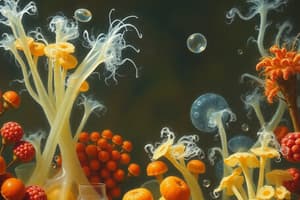Podcast
Questions and Answers
Which of the following is NOT a primary principle in media formulation for microbial growth?
Which of the following is NOT a primary principle in media formulation for microbial growth?
- Maintaining appropriate pH and osmotic pressure
- Ensuring the media is brightly colored (correct)
- Providing necessary growth factors and aeration
- Providing essential elements and energy sources
Defined media have a precisely known chemical composition, making them unsuitable for studying specific nutritional requirements.
Defined media have a precisely known chemical composition, making them unsuitable for studying specific nutritional requirements.
False (B)
Name two key functions of water in the preparation of microbial media.
Name two key functions of water in the preparation of microbial media.
solvent, biochemical reactions
__________ media are used to distinguish between different groups of microorganisms based on their metabolic activities, often indicated by a color change.
__________ media are used to distinguish between different groups of microorganisms based on their metabolic activities, often indicated by a color change.
Match the following media types with their primary function:
Match the following media types with their primary function:
Which mineral source is MOST essential for the synthesis of nucleic acids and ATP in microbial media?
Which mineral source is MOST essential for the synthesis of nucleic acids and ATP in microbial media?
Complex media are advantageous because their exact chemical composition is known, allowing for precise control over nutrient availability.
Complex media are advantageous because their exact chemical composition is known, allowing for precise control over nutrient availability.
Why is autoclaving at 121°C typically used for sterilizing microbial media?
Why is autoclaving at 121°C typically used for sterilizing microbial media?
__________ media are used to enhance the growth of a specific microorganism from a mixed population by providing specific nutrients or conditions that favor its growth.
__________ media are used to enhance the growth of a specific microorganism from a mixed population by providing specific nutrients or conditions that favor its growth.
What role does agar play in microbial media?
What role does agar play in microbial media?
Flashcards
Selective Media
Selective Media
Substances added to media to inhibit certain microbes, aiding in the isolation of specific microorganisms.
Differential Media
Differential Media
Media that allow visual differentiation between different groups of microorganisms based on metabolic activities.
Enrichment Media
Enrichment Media
Media with specific nutrients that favor the growth of a particular microorganism from a mixed population.
Complex Media
Complex Media
Signup and view all the flashcards
Defined Media
Defined Media
Signup and view all the flashcards
Peptone
Peptone
Signup and view all the flashcards
Agar
Agar
Signup and view all the flashcards
Carbon Sources
Carbon Sources
Signup and view all the flashcards
Nitrogen Sources
Nitrogen Sources
Signup and view all the flashcards
Growth Factors
Growth Factors
Signup and view all the flashcards
Study Notes
- Media formulation involves selecting and combining nutrients to support microbial growth
- The principles ensure the media provides essential elements, energy sources, and necessary growth factors
- These principles also aim to maintain appropriate pH, osmotic pressure, and aeration
Nutrient Composition
- Media must contain carbon sources for energy and cellular synthesis
- Nitrogen sources are required for protein and nucleic acid production
- Minerals such as phosphorus, sulfur, potassium, magnesium, calcium, and iron are critical
- Growth factors like vitamins or specific amino acids are vital for organisms that cannot synthesize them
- Water is essential as a solvent and for biochemical reactions
Carbon Sources
- Sugars (glucose, lactose) are common and easily metabolized carbon sources
- Complex carbohydrates (starch, cellulose) can be used by microorganisms that produce corresponding enzymes
- Lipids and hydrocarbons can support the growth of specific microbes
Nitrogen Sources
- Amino acids and peptides provide readily available nitrogen
- Inorganic salts like ammonium salts (NH4Cl) and nitrates (KNO3) can be utilized
- Some microbes can fix atmospheric nitrogen (N2)
Mineral Sources
- Phosphates (K2HPO4, KH2PO4) provide phosphorus for nucleic acids and ATP
- Sulfates (MgSO4) supply sulfur for amino acids and vitamins
- Potassium (KCl) is important for enzyme function and osmotic balance
- Magnesium (MgSO4) is a cofactor for enzymes and stabilizes ribosomes
- Calcium (CaCl2) contributes to cell wall stability in bacteria
- Iron (FeCl3) is a component of cytochromes and iron-sulfur proteins
Growth Factors
- Vitamins (biotin, thiamine) are enzyme cofactors required in small amounts
- Amino acids are needed by auxotrophic organisms that cannot synthesize them
- Purines and pyrimidines are necessary for nucleic acid synthesis in some microbes
Water
- High-purity water (distilled or deionized) is used to prepare media
- Water ensures all components are dissolved and available for microbial uptake
Media Ingredients
- Media ingredients are classified based on their role and complexity
- Defined media contain precisely known amounts of pure chemicals
- Complex media contain ingredients of biological origin with inexact chemical compositions
- Selective media promote the growth of specific microorganisms while inhibiting others
- Differential media distinguish between different groups of microorganisms based on their metabolic activities
- Enrichment media contain specific nutrients to favor the growth of particular microorganisms
Defined Media
- Also known as synthetic media, defined media have a known chemical composition
- Useful for studying specific nutritional requirements and metabolic pathways
- Example: A minimal salts medium with glucose as the carbon source
Complex Media
- Complex media include ingredients like yeast extract, peptone, and beef extract
- The exact chemical composition is unknown, but provides a wide range of nutrients
- Support the growth of many different microorganisms because they supply a variety of growth factors
- Example: Nutrient agar and tryptic soy broth
Selective Media
- Selective media contain substances that inhibit the growth of certain microorganisms
- Antibiotics, dyes, or specific chemicals are added to inhibit growth
- Useful for isolating specific microorganisms from mixed cultures
- Example: MacConkey agar selects for Gram-negative bacteria while inhibiting Gram-positive bacteria
Differential Media
- Differential media allow different microorganisms to be distinguished visually
- Indicators (e.g., pH indicators) are used to detect metabolic differences
- Example: Blood agar differentiates bacteria based on their ability to lyse red blood cells (hemolysis)
- Example: MacConkey agar differentiates lactose fermenters from non-fermenters by a color change
Enrichment Media
- Enrichment media enhance the growth of specific microorganisms from a mixed population
- Specific nutrients or conditions favor the growth of the desired microorganism
- Often used when the target microorganism is present in small numbers
- Example: Selenite broth enriches for Salmonella species
Common Media Ingredients
- Agar is a solidifying agent derived from seaweed
- Peptone is a protein hydrolysate that provides amino acids and peptides
- Yeast extract supplies vitamins, amino acids, and minerals
- Beef extract provides amino acids, peptides, nucleotides, organic acids, vitamins and minerals
- Salts provide essential ions and help maintain osmotic balance
Specialized Media
- Transport media maintain the viability of microorganisms during transport
- Assay media are used for quantitative determination of specific substances
- Anaerobic media are formulated to support the growth of anaerobic microorganisms
Media Preparation
- Media preparation involves weighing the ingredients, dissolving them in water, and sterilizing the mixture
- Sterilization is typically achieved by autoclaving at 121°C for 15-20 minutes
- Filter sterilization is used for heat-sensitive components
- Aseptic techniques are crucial to prevent contamination during preparation and use
Factors Affecting Media Performance
- pH is critical for enzyme activity and nutrient availability
- Buffers are added to maintain a stable pH
- Osmotic pressure affects cell integrity; salt concentration must be controlled
- Aeration is essential for aerobic microorganisms, while anaerobic conditions are required for anaerobes
Quality Control
- Quality control ensures that media are sterile and perform as expected
- Sterility checks involve incubating media to detect any growth of contaminating microorganisms
- Performance testing assesses the ability of the media to support the growth of the target microorganisms
Studying That Suits You
Use AI to generate personalized quizzes and flashcards to suit your learning preferences.




